One thing I've learned over the past 20 years of teaching is that learning styles are really more about teaching styles. There are many different types of learning styles and it's important to make sure that we are teaching all learners and giving students the tools they need to succeed in the classroom. One example of how to accomplish this challenge in your own classroom is by improving access to the assigned reading for all students. To help, I am going to share the tools and strategies I use to engage all students in the nonfiction reading component of the KnowAtom science curriculum.
KnowAtom's next generation science standards (NGSS)-designed curriculum uses a similar routine for each lesson so that students begin to know what to expect. For each lesson within every unit, we start out reading. Students then take part in a Socratic dialogue using what they've learned from the reading. Next, we plan for a hands-on experiment, investigation, or engineering prototype. To wrap up the investigation, teams share their conclusions and debrief. As you can see, the nonfiction reading provides the launching point for each lesson.
No matter what level a student is reading at, whether they are an English language learner or whether they are predominantly a visual vs. an auditory learner, it's important that they can access the information in the reader upfront. To help students with different types of learning styles access the nonfiction text, teachers must understand how students learn differently. One popular model is the VARK learning styles theory. VARK identifies four different learning styles: visual, auditory, kinesthetic, and reading/writing. While most students have a combination of these different types of learning styles, some students learn predominantly from only one.
Connecting new phenomena to past experience
When beginning a new lesson, teachers should consider what knowledge and experiences students bring with them to the class. By establishing a common background when introducing new phenomena, teachers help level the playing field for students who are at different places along their learning journey.
For example, if we're investigating friction and the impact that a dog sled might have moving over snow, that context would be really difficult for a student who hasn't experienced snow to think about. "I don't understand because I don't know what it's like to walk on snow. I don't know the properties of snow. I haven't experienced that," the student is thinking. With the KnowAtom curriculum, the text before every unit helps give every student a common background and some insight into the phenomena they're about to explore.
For students with reading/writing predominance in their VARK learning style, reading the text before the hands-on experiment helps them understand the new concept when it is introduced. But that's not the only type of learning style you have in your classroom. Visual learners are better supported by the visuals in the nonfiction reader, including photos, charts, and graphs with explanatory text. Auditory learners may learn best from classroom discussions about the reading and can be supported by tools like sentence starter frames and annotating the text, so they come to the class discussion with the right questions to ask. Finally, kinesthetic learners learn from doing – and the tactile experience of completing an engineering project related to the new concept will help them better understand the lesson.
Another way students with all different types of learning styles can relate to the nonfiction text in the KnowAtom student readers is by connecting the new information to current knowledge – what they've learned before. Students start to think about, "Oh, I remember learning a little bit about that last year," or "I experienced something like this when I was cooking at home and the water started to boil." When working in pairs, small groups, or as a class – teachers can help students connect new phenomena with current knowledge by asking questions about what they've learned from the text and what it reminds them of.
KnowAtom's introductory text helps students start to think about what they will be exploring in the hands-on activity. It introduces or reinforces the vocabulary needed for the Socratic discourse, so students feel more comfortable joining in the classroom discussion. When using KnowAtom's NGSS-designed curriculum, we challenge our students to act like scientists and engineers, interacting with their peers in a professional setting. This helps level the playing field even further because all students are accessing the same vocabulary when discussing the new phenomenon and understand the rules of engagement when taking part in the classroom discussion.
Tools to strengthen reading fundamentals for all types of learning styles
One of the first things I do to help improve access to the reading material for all students is using prereading tools. The majority of my students are English learners, so they are often not reading at grade level yet. One tool I use to help them access the text is focusing on pictures. Asking students to find meaning in the images in KnowAtom's student readers and using a picture thinking graphic organizer helps them identify the images' object, action, and property. Students build critical thinking and active reading skills as they wonder what they will be reading about through the images and connect it to their current knowledge. This can be done together as a class, or in small student groups, or individually.
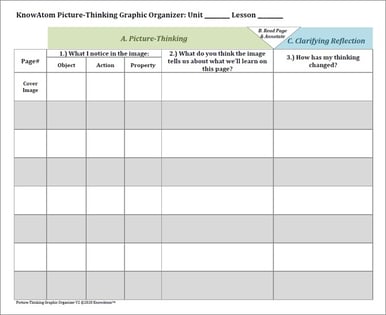
There's another tool I use to help all readers access the same text – read-aloud videos. For every grade level and every lesson, KnowAtom has created read-aloud videos of the nonfiction text. Students can access the videos online by grade level and unit. When they click on the read-aloud video, the student follows along with the text as it tracks on the screen. The tool works the same for lower and higher grade levels, with each reader listening, following along, and tracking with the reading.
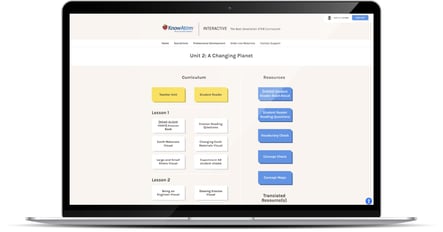
The read-aloud tool can be used in many different ways. You can do the read-aloud together as a class, discussing the text as you go. During virtual learning, students can access the read-aloud tool on their own. Parents and caregivers can also use the website link and listen to it together with their students. For students who have read the text on their own, the read-aloud can be used afterward for additional support.
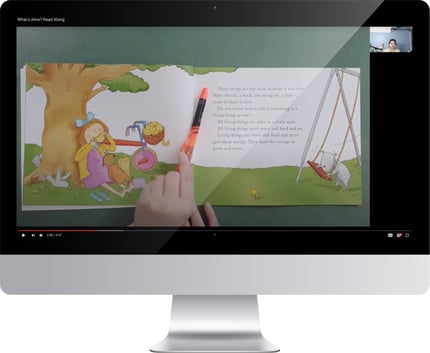
Do you see how these two reading tools support students with different learning styles? With prereading using a visual focus, we can spark the interest and attention of visual learners. With the read-along tool, we're supporting both auditory and visual learning styles, as well as reading/writing. For students with different types of learning styles, the vark learnings styles model can help us identify how to support and improve access to the nonfiction text.
Evaluating how our thinking has changed
Once the reading portion of the KnowAtom lesson is complete, students use the picture thinking graphic organizer to evaluate what has changed in their thinking. Each student made some predictions based on the pictures before completing the reading. Once they've read and listened to it, it's time to think about how the information they learned relates to what they thought the reading was about. This is such an important part of each unit. Students strengthen critical thinking skills and learn that it's okay to change their minds when they learn new information about a topic. As they make connections between what they already know and what they learned from the pictures, the text, and the classroom discussion – they are making high-level connections to the new phenomenon in each unit.
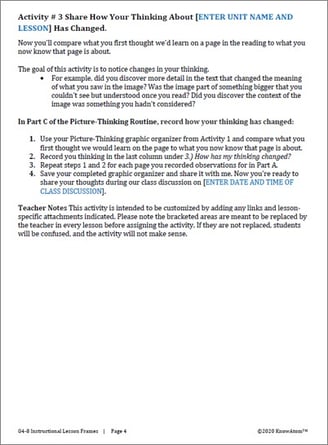
When students respond with, "I've always wondered about," or "That sounds really interesting, and I want to learn more about it," we've accessed their curiosity about the world around them and energized their desire to learn more. A student who responds, "I'm confused about..." is also learning an important part of the lesson. We're teaching our students it's okay to say they don't understand. It's okay to question and be confused. We're encouraging students to identify and share their questions while giving them the tools they need to communicate them to the group. That leads to richer student-led discussions on the topic and how it connects to what classmates already know and what they will learn next.
I tell my students, "If you're confused, chances are someone else is too, and you're helping the entire class by speaking up. So, let's get all those questions out on the table." In our classroom discussions, someone else may already understand and be able to help. Or we could figure out together where we could go to find out more. We can also strengthen our own understanding by listening to different perspectives. That's an exciting thing about teaching science, when our students' questions lead to more, for example:
• I'm going to do this experiment because I'm confused about this.
• Let's think a little bit more about how we can figure out the answer to that question.
• That's a confusing situation, is there something that we can do to solve that?
• I've never thought about that.
Learning that introducing other perspectives expands our own view and strengthens our understanding is a powerful lesson. Using the picture thinking graphic organizer can help learners of all types access this type of high level of thinking, by asking "How has my thinking changed?" This makes reading an exciting activity, as students link it to better understanding the world around them. It turns reading into something that students see as important. This is an especially powerful lesson for students with different learning styles, especially those who don't depend on reading as their primary mode of accessing and understanding new information.
Here are two examples of success from my students using the picture-thinking model:
• "I thought salt was in the bottom of the ocean. I used to think this, and now I've learned something different. I did not realize there was so much water on earth. That's a wow! That's a great discovery. I didn't know that."
• "I remember the word evaporation from fourth grade, but now I understand why it happens."
It's important to know the definition of the word evaporation, but how much more powerful is understanding why evaporation happens? That's such a powerful thing for a student to understand – there are different levels of thinking and based on the reading, your thinking went so much deeper.
Classroom discussions for different learning styles
After the nonfiction reading is complete, it's time for students to move on to the Socratic dialogue. Even if students are not reading at grade level, are non-readers, or are English learners, you've already given them a lot of material to talk about. They are prepared to be active participants in the discussion. With tools that support learners of all styles and readers of all grade levels, you've given them the power to bring "I'm confused" into the discussion and identify information from images, past knowledge, and connections to the new phenomenon to share with their peers.
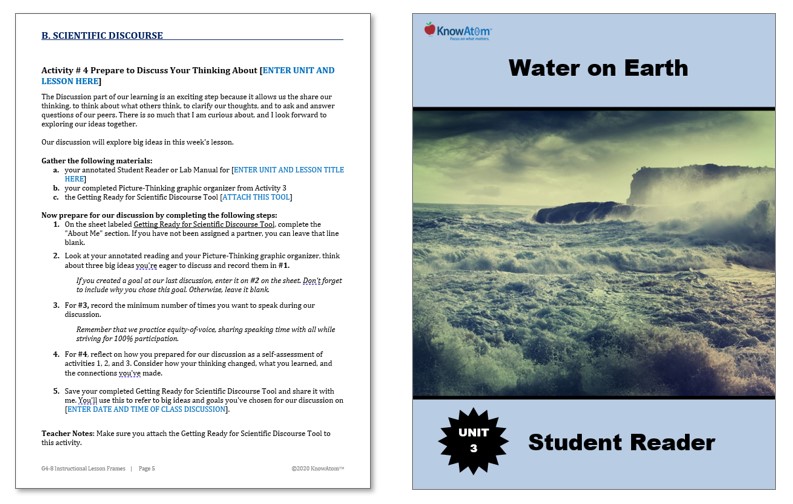 As a teacher, it's exciting to help students understand that joining a discussion doesn't have to mean that you know everything. A discussion is you bringing your thoughts and questions into the mix with the hope of learning more; what an important 21st-century career skill to introduce to students at all grade levels.
As a teacher, it's exciting to help students understand that joining a discussion doesn't have to mean that you know everything. A discussion is you bringing your thoughts and questions into the mix with the hope of learning more; what an important 21st-century career skill to introduce to students at all grade levels.





